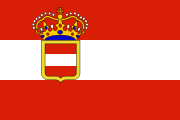- Rudolf Montecuccoli
-
Rudolf, graf Montecuccoli degli Erri (22 February 1843-16 May 1922) was chief of the Austro-Hungarian Navy from 1904 to 1913 and largely responsible for the modernization of the fleet before the First World War.
Contents
Overview
Montecuccoli was born in Modena in 1843, a descendant of the famous imperial Feldmarschall, Raimondo Montecuccoli (1609-1680). Raimondo Montecuccoli's only son died in 1698, but the title of count descended through his daughters to two lines, Austrian and Modenese.
When Rudolf Graf Montecuccoli was born, Modena was still an Austrian Habsburg possession, ruled by the house of Austria-Este. During the 1859 Italian campaign, however, the last Habsburg Duke of Modena, Francesco V, fled to Austria following the Austrian defeat at Magenta (4 June). Italian patriots seized control, demanding union with the Kingdom of Sardinia. This was confirmed by plebiscite in March 1860, and at the age of 17 Montecuccoli saw his birthplace and ancestral home pass under a foreign sovereignty. (A year later, Modena became part of the Kingdom of Italy.)
Educated as a naval officer, Montecuccoli was little known outside the Austro-Hungarian naval establishment before his appointment as Marinekommandant (Navy Commander) and Chef der Marinesektion (Chief of the Naval Section of the War Ministry in October 1904, upon the resignation of Hermann von Spaun.
Montecuccoli found his efforts to modernize the fleet impeded by chronic domestic political friction in the annual budget debate of the Reichstag, which was composed of 60-member delegations from the Austrian and Hungarian parliaments. Faced with Italian plans to build a dreadnought battleship, Montecuccoli on 20 February 1908 announced Austria-Hungary's intention to build such vessels. The design was accepted on 27 April 1909; Montecuccoli thought the necessary funds could be obtained in the 1910 budget, to be debated in October 1909. He suggested that Stabilimento Tecnico Triestino (STT) and Skoda should begin construction of the ships and guns on their own account until the naval budget was adopted.
When the time came, the Reichstag denied the funds for domestic political reasons. Montecuccoli was compelled to resort to an intricate web of propaganda and deception to camouflage the fact that the new ships did not have Reichstag approval. He asserted that industry was financing the construction of two dreadnoughts on speculation; this was completely untrue, and both STT and Skoda were extremely nervous about the subterfuge. In the event, Viribus Unitis and Tegetthoff could not be laid down until after Montecuccoli took an expensive 32 million crown credit in 1910 upon his own responsibility. By that time Italy had launched Dante Alighieri and laid down three more dreadnoughts, and France had laid down Courbet, her first.
The first Austro-Hungarian dreadnoughts were thus already under construction when the Reichstag delegations met in March 1911 to consider the 1911 budget. Viribus Unitis and Tegetthoff were authorized retroactively by the deputies, who also sanctioned construction of Prinz Eugen and Szent Istvan.
Montecuccoli retired as head of the naval administration on his 70th birthday, 22 February 1913, and was succeeded by Anton Haus. The Austro-Hungarian fleet, so arduously modernized by Montecuccoli and maintained in wartime by Haus as a 'fleet in being', was parcelled out among the victorious powers after 1918. Montecuccoli died in Baden-bei-Wien in 1922 at the age of 79.
References
- Conway's All the World's Fighting Ships 1906-1921.
- Jane's Fighting Ships 1914.
Notes
- Graf is a title, translated as Count, and not a first or middle name. The feminine form is Gräfin.
- It is somewhat ironic that Rudolf Graf Montecuccoli was an Austrian admiral of Italian origin -- his famous 17th-century ancestor Raimondo Montecuccoli was the namesake of an Italian light cruiser launched in 1934.
See also
Military offices Preceded by
Hermann von SpaunCommander-in-Chief of the Austro-Hungarian Naval Fleet
1904 - 1913Succeeded by
Anton HausCategories:- 1843 births
- 1922 deaths
- Austro-Hungarian admirals
- Austrian nobility
- People from the Province of Modena
- Honorary Knights Grand Cross of the Royal Victorian Order
Wikimedia Foundation. 2010.

